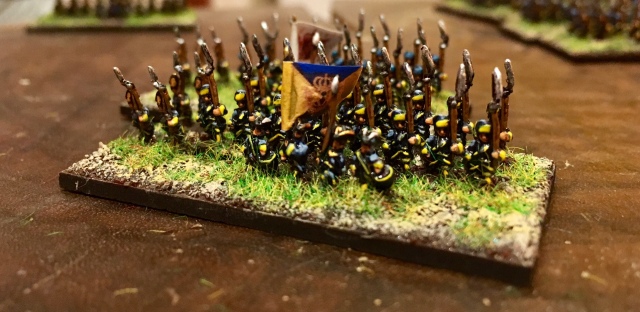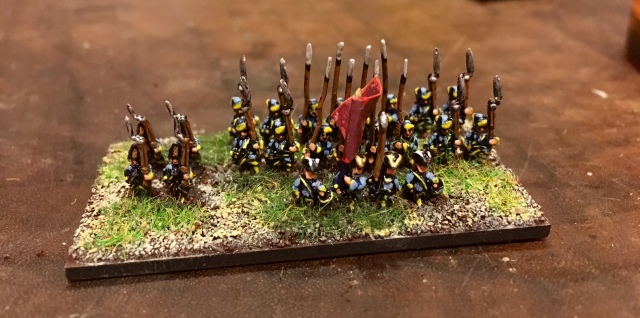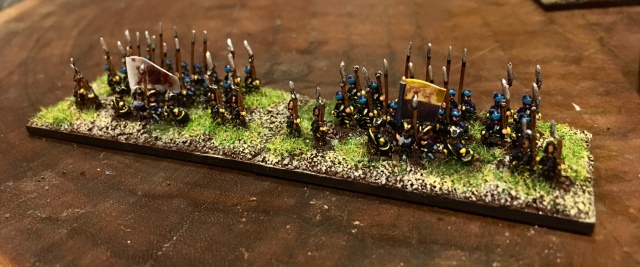True to my words, at least this time, last weeks effort were focused on the main project. 17 bases of infantry inked, highlighted, based and flagged this weekend from the base painted pile. More on this below. It is nice to do some 6mm again.

I am really happy I managed to get that famous finger out of that dreadful place and get these done. I have had too many diversions lately on the hobby front with the Terminator stuff (did I say Terminators, Sorry!) and other pleasant non-priority things. On the personal front I had to go to France for a funeral earlier in the week. This was for a very special Lady who touched many hearts and inspired me in so many ways over the years, she truly was a manifestation of her own favourite poem “A thing of beauty, is joy forever” (link to it here). Hats off for you Dr. Bardaux!
I also got those flags I talked about to use for the French and Indian War games, one Nouvelle France flag and also the Kings Colours (looks very good, me thinks!).

Swedish Infantry at Lesnaya
The following are the infantry made for the Lesnaya Battle (with some facts from the eminent book by Lars-Erik Höglund and Åke-Sallnäs, The Great Northern War 1700-1721 – Colours and Uniforms).
Estlänskt Infanteriregemente (de la Gardie), 2 battalions.
This was an enlisted regiment and raised in 1700 by the Governor General of Estland A.J. de la Gardie. After the Lesnaya Battle the regiment, due to heavy losses, where incorporated into the Västerbotten Regiment and fought in the Poltava Battle in 1709. They did not carry pikes and both battalions of the regiment were present at the Lesnaya Battle. The regiment, together with a battalion of the Närke-Värmland Tremänning regemente, formed the rearguard that were first attacked by the Russians.

Närke-Värmland Tremänning regemente, 1 battalion.
This was a temporary regiment that was raised in 1700 and had been reduced to one battalion in 1705. Was, due to losses, incorporated into the Livgardet (Lifeguard) after the Lesnaya battle. As mentioned above, part of the rearguard, that first had contact with the enemy at the battle.

Hälsinge Regemente, 2 battalions.
This was a regular indelta (provincial) regiment and had its origins from the 16th century. The survivors from the battle was transferred to the Dalregementet. The regiment was one of three regiments that first came to aid to the rearguard that was being attacked by the Russians.

Upplands, Västmanlands och Dalarnas Tremänning regemente, 2 battalions.
Another temporary regiment raised in 1700 and the survivors after the Lesnaya Battle was incorporated into the Livgardet. Was part of the early support force sent to help the rearguard.

Åbo Läns regemente, 1 battalion.
A regular provincial (finnish) regiment created in the 17th century. It had one battalion with the Lewenhaupt army (the other retained for fortress duty). As for the two regiments above part of the early support force.

Småland Tremänning regemente, 2 battalions.
Yet another temporary regiment that was raised in 1700 and you guessed it, due to losses, incorporated into the Livgardet (Lifeguard) after the Lesnaya battle. This like the other 3 regiments below was at Lesnaya during the Battle.

Åbo, Björneborg och Nylands Tremänning regemente, 2 battalions.
Temporary regiment that was raised in 1700 and it is not perfectly clear whether one or two battalions joined Lewenhaupts Army. Survivors after the battle were incorporated into the Västmanland regimente.

Öselska Lantmilisbataljon, 1 battalion.
This was a militia force raised in 1702 and took heavy losses at Lesnaya and after this was incorporated into the Västerbotten regimente. They did not carry pikes.

Österbotten regemente, 1 battalion.
A regular provincial (finnish) regiment created in the 17th century. It had one battalion with the Lewenhaupt army (the other retained for fortress duty). Survivors from the Lesnaya Battle were put into the Närke-Värmland regimente.

Nylands regemente, 1 battalion.
A regular provincial regiment created in the 17th century. It had one battalion with the Lewenhaupt army (the other retained for fortress duty). Was sent to enforce the troops at Lesnaya. Survivors after the Battle were placed in the Västmanland Regemente.

Björneborgs regemente, 2 battalions.
A regular provincial (finnish) regiment created in the 17th century. As for the Nylands regmente it came as an enforcement to the troops at Lesnaya. Survivors after the Battle were placed in the Västmanland Regemente.

/ See you next week

Those figures are looking very good.
Am I correct in assuming that the formations you’ve arranged the figures in reflect real methods of deployment?
Cheers
Richard
LikeLiked by 1 person
Richard,
Thank you!
Two strands to answer this, (i) the selection of type of miniatures and (ii) the arrangement of these on the base.
Each base represents a battalion about 600 man strong and in most case two of these forms a regiment and each of the battalions was 4 companies strong. Each company (with pikes) had 12 grenadiers, 84 musketeers and 48 pike men. Giving these the weightings are 8% grenadiers, 58% musketeers and 33% pike men. As I am using 24 miniature per base (1:25 Ratio) this gives 2 Grenadiers, 14 musketeers and 8 pike men. However, I have used a little bit of artistic liberty and have kept the pike men (if present) to 8 but have included either 0 or 4 Grenadiers. Then rest being the command strip and musketeers. This in comparison to the Russian Infantry that normally had a 1 in 6 ratio of pikemen (i.e. in my Russian infantry bases I include 4 pike men per base).
You can read more about it here
http://www.xenophon-mil.org/rusarmy/orel/swedishinfantrypoltava.htm
For how I have placed the soldiers on the base I have used the diagram in the link below as a basis (see alternative B) with pikes in the middle and other units on the side with grenadiers on the flanks. Drummers could perhaps have been placed at the back, which would have been more correct, but I went for the more pleasing look.
https://en.wikipedia.org/wiki/Battalion_(Sweden)
So to answer your question, yes it reflects at a high level real methods of deployments but some artistic liberty was taken.
Good question. I will do a blog entry in the next few weeks on how I base the units for the GNW units, including commanders. I need to dust of my forces for the Kalisz battle at Salute and might as well take some pictures as these represent a wide range of troop types (from normal WSS type units to Winged Hussars).
Hope this helps,
/ All the best
LikeLiked by 1 person
Thank you for both such a comprehensive reply and the links. Just spent my lunchtime reading the links, quite fascinating and it’s always good to see people attempt to replicate the actual organisations and formations. Look forward to the basing blog post.
Cheers
Richard
LikeLike
Pingback: Towards Moscow Trilogy (TMT) – Part 5, Swedish Cavalry at Lesnaya – Roll a One